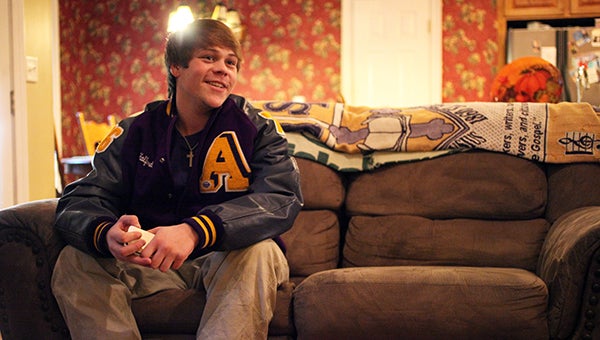St. Al senior has ‘just do it’ attitude toward diabetes
Published 12:00 am Saturday, November 28, 2015

- DO IT OR DIE: St. Aloysius senior Jimbo Halford, who was diagnosed with diabetes in January 2008, has continued playing sports and will attend Hinds Community College in the Fall.
Every morning, Jimbo Halford begins his day with the same routine.
Bleary-eyed, he makes his way to the kitchen, finds the small penlike device with the sharp point, and jabs it into his finger. The drop of blood that forms is gently smeared on a small strip of paper and put into another device, which provides a digital readout.
Halford looks at the number, then goes to the refrigerator to pull out a vile of insulin. Filling a syringe, he finds an open patch of skin along his arm or torso and jabs himself again, this time injecting the life-giving fluid.
The 17-year-old St. Aloysius High School senior has done this, without fail, for seven years, ever since he was diagnosed with diabetes. God willing, he’ll do it for the next 70. He knows what can happen if he doesn’t.
“You’re not getting rid of it, so you might as well deal with it. You can whine about it, but that’s not going to make it better,” Halford said. “Do it or die.”
Halford is one of an estimated 208,000 Americans under the age of 20 who have been diagnosed with diabetes. According to statistics from the American Diabetes Association, roughly 29.1 million adults in the U.S. — nearly a quarter of them undiagnosed cases — have the disease.
When he was 11 years old, Halford went from the undiagnosed column to diagnosed in a matter of days.
Halford hadn’t been feeling well for several days. His mother believed it was the flu or a stomach virus, and treated it accordingly. The family had no history of diabetes and, although Jimbo weighed 250 pounds in the fourth grade, there was no reason to suspect it was anything other than an ordinary illness.
“We were feeding him Sprite and Jello,” Mary Halford said, quietly laughing at her naivete.
On Jan. 30, 2008, Jimbo crashed.
Hard.
He passed out on a couch in the family’s living room and his parents weren’t able to wake him. They called an ambulance but still did not grasp the severity of the situation.
“They strapped him down and put him in there and we took pictures, figuring when he woke up he was going to laugh about getting a ride in an ambulance,” Mary Halford said.
Jimbo didn’t wake up for four days. His blood sugar had skyrocketed to 1,400 milligrams per deciliter of blood — a reading of between 100 and 180 is considered normal — and he’d fallen into a diabetic coma.
He was put into the intensive care unit at River Region Hospital in Vicksburg and airlifted to Blair E. Batson Children’s Hospital in Jackson later that night. What didn’t appear to be anything more than a run of the mill virus a few hours earlier had quickly turned into a matter of life and death.
“They were saying he could have brain damage. From Wednesday to Saturday, he stayed in a coma,” Mary Halford said. “They said they had never seen a reading that high. He holds a record. It’s not a good record, but he holds a record.”
Jimbo remained in the coma for four days, but eventually responded to treatment and came out of it. His mother credited the hospital staff, his doctor, Michael Davis, and a higher power.
“He was on every prayer list,” she said. “Not just our Catholic family, but every church around here.”
Although the immediate danger had passed, Jimbo was far from being back on his feet. He spent nearly five months recovering in the hospital and in rehab. He finally returned to school that May, but then had to come to grips with the harsh reality of living with diabetes.
There are two kinds of diabetes, Type 1 and Type 2. With Type 1, the pancreas stops making insulin. With Type 2, it still makes some, but doesn’t regulate it. That means Jimbo’s blood sugar can fluctuate wildly depending on the time of day. If he hasn’t eaten, or when he first wakes up, it can be low. If he eats something with too much sugar, it can spike dangerously high.
To keep it in check, Halford injects himself with a dose of insulin twice a day and monitors it regularly. He must also be careful about what he eats.
No sweets are allowed. No sodas. Candy or cookies help if his sugar is low, but must be avoided if it’s high. Anything with an excess amount of sugar, like the treats that so many children enjoy on a daily basis, were placed off-limits.
Jimbo also has to be cognizant of where his medicine is at all times. St. Aloysius keeps a few emergency doses on hand at the school, but if he’s off on his own or out of town he runs the risk of being caught unprepared.
It’s a burden and a responsibility, but one Halford said he’s come to accept.
“When all your friends are going to do stuff and I have to worry about my medicine, it’s hard. But I just have to do it. I have it for my life,” he said. “You’ve just got to learn to do it. Somebody’s not going to be in my ear chewing on me 24-7.”
Halford isn’t alone in his struggle. He said his friends keep a close eye on him to make sure he’s eating right. Some of them have even snitched to his parents and sister if they catch him drinking a Coke.
“My friends are getting rid of stuff too. They all started doing sugar-free and diet drinks after I was diagnosed,” Jimbo said. “At football, Coach (Jimmy) Salmon would always have a couple of pieces of candy in his pocket if my sugar starts to drop.”
Halford has also developed healthier eating and exercise habits, which helps regulate blood sugar. He’s been a member of St. Aloysius’ football team for four years, which has kept him in shape and helped him drop 60 pounds since he was first diagnosed.
Mary Halford said football has had its benefits, but was thankful her son’s playing days were over.
“I’m glad he’s through, because I worried about him getting hit or having kidney damage,” she said.
Jimbo Halford, once a child on death’s door, is alive and well as prepares to pass into adulthood. He’s on track to graduate from St. Aloysius in May, and will eventually be on his own. The way he’s handled himself and grown up with a disease that kills more than 200,000 Americans every year has his mother confident that her baby boy can manage and cope with it.
“I’m still not ready to give up control of him,” she said. “But he’s smart. He knows what he’s got to do.”
Jimbo knows, too. He needs to live his life, and live it to the fullest, while taking the steps necessary to stay healthy.
“I just get up in the morning, check my sugar and take my medicine. I can feel it if it’s too high or too low,” he said. “I try to live my life like normal and don’t let it affect me.”






